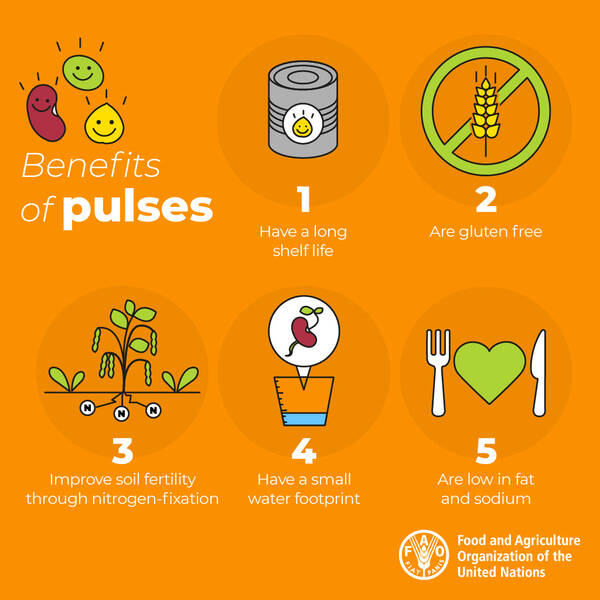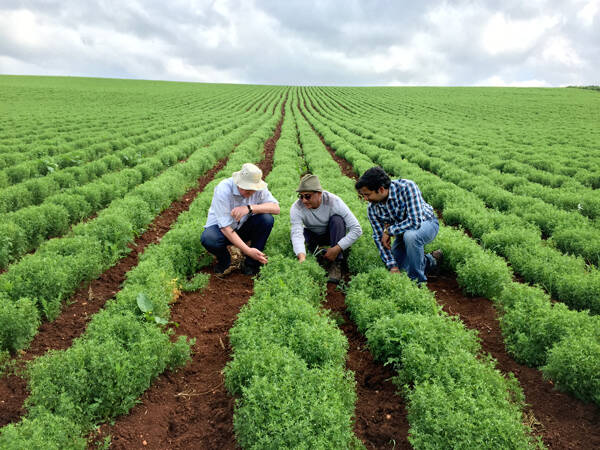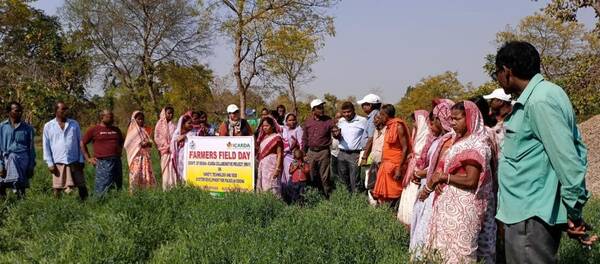Reviving the pulse in food security

It is thanks to the support of CGIAR's CRP GLDC, IITA, ICRISAT, and the Alliance of Bioversity International and CIAT among others that our work on pulses is made possible.
World Pulses Day, hosted by the Food and Agriculture Organization (FAO) of the United Nations, raises awareness about the nutritional benefits of a global wonder food: pulses. CGIAR, the world's largest global agricultural innovation network, is working hard with FAO to raise the profile of these delicious and nutritious crops by showcasing the pivotal role pulses can play in achieving global food security goals and targets.
The ongoing climate crisis highlights more than ever the need to diversify our agri-food systems to more climate-smart ways of producing our food, strengthening supply chains, and improving diets, especially for family farmers and low-income consumers in vulnerable dry regions. ICARDA works alongside other CGIAR research centers with the CGIAR Research Program on Grain Legumes and Dryland Cereals (GLDC), to carry out research on pulses to demonstrate how they can benefit not just family farmers but also world pulses production as a whole, to help achieve global food security targets and better diets at affordable price for the poorest.
Reviving the pulse in global crops
An alternative approach to the global cereal monocropping trend is diversified cropping systems that combine cereals and legumes. CGIAR’s research demonstrates that farmers have better dietary options when cereal planting is rotated or diversified with legumes. Yield quantity and quality also improve, along with income.
Worldwide, cereals are the most widely cultivated staple crop, yet few developing countries meet their wheat demand through domestic production. They instead depend on expensive imports and, to meet demand, encourage unsustainable monocropping food production systems. Monocropping strips the soil of its fertility and increases pests, diseases and weeds, reducing yields and nutritional quality, and creating a vicious cycle of over-demand and inability to supply. Undertaking an integrated and holistic approach to diversify cereal-based agri-food systems is urgently needed.

Less meat, more pulses - if governments say so.
According to a recent survey by the European Investment Bank, 60 percent of the European respondents have reduced their meat consumption to help fight climate change. France for example, is promoting national and international campaigns and initiatives to accelerate the adoption of crop diversification, with legumes at the forefront.
Yet across global dry regions and Europe itself, diversified cropping systems are not mainstream. This mostly boils down to national policies that do not encourage the practice, limitations around accessing value-chain-ready seed varieties, and difficulties for farmers in finding seeds adapted to local conditions and food industry requirements at affordable prices.
CGIAR scientists, with long experience of scaling pulse-related technologies across smallholding, water-scarce systems, are well placed as global experts on pulse agriculture and are advising on deployment of methods such as diversified cropping systems across dry regions and Europe. Further, CGIAR genebanks covering all pulses and breeding programs on beans, chickpea, lentils, pigeonpea, and cowpea, among others, are crucially important to maintain agrobiodiversity and ensure future genetic gains able to withstand intensifying climate change impacts.

Ready-to-go agricultural innovations
With the ongoing climate crisis and shocks like COVID 19, the inevitable economic backlash, and the large segment of global populations suffering from micronutrient deficiency, CGIAR is demonstrating the significant impact that biofortified lentils can have in boosting health and food security.

- To meet the increasing demand for healthy and environmentally friendly protein and meat alternatives in Europe and beyond, ICARDA, through its INCREASE project in Morocco and Lebanon, collaborated with partners to ramp up the utilization of chickpea, common bean, lentil, and lupin through precision phenotyping and genotyping of global germplasm
- In Myanmar, ICRISAT's early maturing chickpea led to a 51 percent productivity increase for participating farmers in the study region.
- In New Delhi, ICARDA and its national partners have identified eighteen new lentil lines with high iron and zinc content. These are now in use in breeding programs across the South Asian countries, particularly in Nepal and Bangladesh.
- In Nigeria, 40 percent of cowpea growers adopted IITA-improved varieties on over 1 million hectares of land, improving yields by an average of 26 percent. While production costs increased by 14 percent, net returns per hectare increased by 61 percent
- Meanwhile, in South Asia, ICARDA’s early-maturing varieties of lentil, chickpea, and high bio-mass fodder grass pea are planted in vast tracts of idle and fallow land between rice crop seasons. With millions in the region suffering from vitamin and mineral deficiencies, this is a crucial new source of nutrition and income, with the additional crop generating employment to plant and harvest.

Why so hard?
Expanding the cultivation and consumption of food legumes does not have to be at the expense of a region's significant wheat crop production. CGIAR's programs demonstrate that the adoption of crop rotation can result in an almost 50 percent higher nutrient uptake and yield gap reduction in wheat, and food legumes can be grown within intercropping or relay cropping with vegetables and fruits.
Yet farmers willing to adopt new diverse systems face constraints. Legume consumption attracts scant attention, despite its myriad health benefits, and global policies and supply lines continue to favor unsustainable monocropping over innovative agricultural systems that protect our soil resources.
There is still significant research-for-development work needed to convince policymakers, farmers, and other key stakeholders of the benefits of diversified cereal/pulse cropping systems. CGIAR's research establishes that food and nutrition sustainability is enhanced if integrated programs are in place that combines advocacy and systemic innovation systems. With collaborative work and sufficient global funding, these systems and technologies can undoubtedly play a critical role in ending hunger and malnutrition globally.
CLIMATE SMART CROPS AND LIVESTOCK
--------------
CGIAR's research is carried out by different research centers alongside the GLDC.
A huge thanks to all our donors for making this work possible

